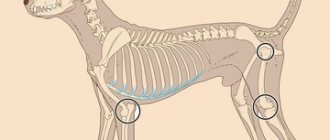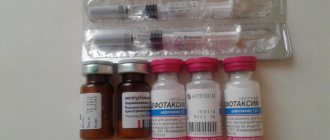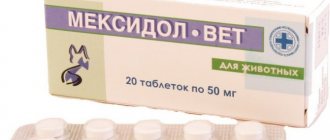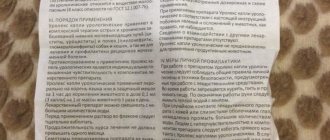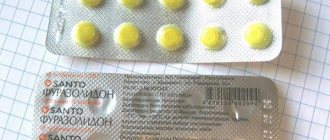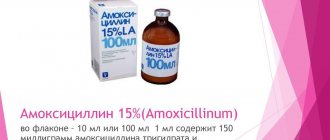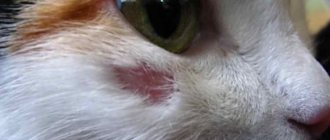Dog owners, without exaggeration, consider them members of their family, therefore animal illnesses are always a heavy blow. Intentional poisonings, unfortunately, are not uncommon lately. Human cruelty and ignorance have given rise to a whole movement of dog haters - dog hunters - who deliberately scatter poison in places where street dogs gather, wanting to get rid of stray animals. But pets often suffer from this as well. In this article we will try to give comprehensive instructions on how to act if a dog shows signs of poisoning with isoniazid, one of the most popular poisons among dog hunters.
Toxicity of isoniazid to dogs
Isoniazid (tubazid, nicotinic acid hydrazide) is a tablet for tuberculosis in humans. Of all mammals, only canines are extremely sensitive to this drug. The drug is so toxic to them because the dog’s body cannot process it due to the weak activity of its own N-acetyltransferase enzyme.
The effect on dogs develops rapidly: tubazide is easily absorbed in the small intestine. Ingestion of a substance into the body leads to:
- A sharp drop in the level of pyridoxine (one of the forms of vitamin B6). The synthesis of GABA (gamma-aminobutyric acid), an important inhibitory neurotransmitter of the central nervous system, decreases, which leads to the development of seizures.
- The formation of lactic acid in the muscles increases , and under the influence of poison its excess is not processed. Next, the metabolic process of glucose formation is disrupted - the monosaccharide ceases to enter the brain cells. The development of hypoglycemic coma is accompanied by failure of some parts of the brain and paralysis of the respiratory muscles.
- The animal dies from oxygen starvation and poisoning by products of impaired metabolism. Death occurs in a state of upset consciousness, when the dog does not feel pain.
Isoniazid tablets are easy to buy at any pharmacy. Knowing the harm the drug can cause to animals, dog hunters can purchase anti-tuberculosis medicine without a prescription to add tablets to deadly baits and poison dogs. The natural urge to vomit for animals is blocked by anti-emetic drugs added to the bait. Therefore, without timely assistance, a mixture of drugs can kill an animal in a matter of hours.
“Humane mission” of dog killers
Author Arthur Priymak
10/11/2011 15:00 (Updated: 11/09/2019 14:41)
Society » Practice
A month ago, the Rossiya channel showed a story. The head of the Boinsky village council of the Tambov region, Yuri Vereshchagin, was driving through the village in his car. The homeless “Caucasian” Lakki caught Vereshchagin’s eye. Vereshchagin stopped the car, tied the dog to the car, put a noose around his neck and dragged him at full speed along the asphalt. The car moved one and a half kilometers at a speed of 100 kilometers per hour.
Ukrainian authorities burn dogs
Two weeks before the incident, the “Caucasian”, abandoned by his owners, settled next to the village store, becoming a favorite of children and pensioners who fed him.
When the head of the village council finished the execution, the dog lay unconscious on the asphalt. Vereshchagin untied Lucky from the car, abandoned the mutilated dog on the road and left to go about his business.
Soon Lucky was found by local residents. The dog was taken to the veterinary clinic. The dog received a laceration from the noose, a rupture of the groin, peritoneum and liver, hematomas on the lungs, spleen, heart and liver, and more than a liter of blood was found in the abdominal cavity. 3 days later, Lucky died.
Signs of poisoning and development of intoxication
Since isoniazid acts extremely quickly on dogs, and the lethal stage can occur in 2-4 hours, it is very important to recognize the early signs of the disease in a dog as early as possible and begin treatment immediately.
The first symptoms of isoniazid poisoning in an animal can be observed within 30 minutes after the substance enters the body:
- the animal's coordination of movements is impaired: the dog staggers, its paws give way;
- further reactions to the poison include vomiting, increased salivation, and foamy discharge from the mouth;
- at a severe stage, tubazide poisoning in dogs is accompanied by respiratory distress and convulsions;
- the animal’s consciousness is disturbed, characterized by panic or complete stupor;
- the dog then falls into a coma and dies.
However, no matter how terrible the clinical picture may be, timely therapy can save the animal.
First aid and subsequent treatment
The maximum concentration of the toxin remains in the dog’s blood for 1-2 hours after it enters the body. This period is the borderline for providing assistance.
There is no point in waiting for the first signs of poisoning: if a dog picks up something from the ground, you need to immediately induce vomiting; doing this if there are signs of isoniazid poisoning is already pointless.
A weak solution of potassium permanganate or 3% hydrogen peroxide (diluted in water in a 1:1 ratio) will help to force the dog to vomit. For 1 kg of dog's weight, 1-2 ml of solution should be poured into the cheek with a syringe. It is necessary to dissolve the peroxide - otherwise the dog risks getting a burn to the mucous membrane of the oral cavity, esophagus, and stomach. A couple of minutes after the solution gets inside, the dog will vomit. (And yes, you should take a first aid kit with you on a walk, especially if there is information about the activity of dog hunters in your area.)
If your dog exhibits symptoms of isoniazid poisoning, you need to focus on other measures. First, he needs to be taken to the vet as soon as possible. When this is not possible, emergency assistance must be provided by the owners. The animal's serious condition is caused by an acute lack of pyridoxine (vitamin B6) - this is the only antidote to tubazide. So, replenishing the lack of substance in the body will help normalize the pet’s condition.
The antidote for isidoazine poisoning of a dog is administered not based on the weight of the animal, but on the amount of poison ingested. A typical bait contains up to 3 g of poison, so to restore the level of pyridoxine you need to administer approximately 60 ampoules (50 mg/ml) of vitamin B6, i.e. the medicine is administered in a ratio of 1 to 1. Drip and intravenous administration of the drug is preferable, but in an emergency it will be enough to inject the medicine into the muscle (in the thigh) and subcutaneously. Even if you are taking your animal to the doctor, administering the medication along the way will be beneficial.
In ml ampoule - 50 mg of pyridoxine. Thus, 3 grams of antidote will correspond to 60 ampoules.
There is an opinion that isoniazid poisoning in dogs can be treated with the drug piracetam (nootropil). It is worth saying that nootropil is not an antidote to isoniazid. The popularity of the approach is explained by the fact that piracetam is a structural analogue of GABA, the production of which is disrupted due to tubazide poisoning, which leads to convulsions. Like the use of vitamin B6, the use of piracetam acts as replacement therapy. Piracetam is administered intravenously by drip along with saline, sometimes ascorbic acid is added to the dropper.
Tubazide poisoning causes a catastrophic energy deficiency, so after replacement therapy in the veterinary clinic, the dog is injected intravenously with an ATP solution (0.1 ml per 1 kg of weight) - a universal source of energy for all biochemical processes in the body.
Next, the animal is given a drip with buffer solutions that help cleanse the blood as quickly as possible. At the same time, the dog is given an injection with diuretics to stimulate the kidneys to remove toxins. Thus, high doses of isotonic solutions and diuretics are combined.
We strongly recommend that you read the original open letter from the vetmedical website community on the topic of the article at the link.
Signs of isoniazid poisoning
The main symptoms of isoniazid poisoning include:
- deviation in movement coordination. The animal may stagger when walking, hit corners or fall on its side;
- drowsiness. The dog constantly wants to sleep and does not obey the owner;
- strong salivation. Saliva simply flows from the mouth, in some cases foaming;
- profuse vomiting;
- convulsions that spread to all muscle groups of the mongrel;
- disorders of the respiratory system. There is shortness of breath and rapid breathing.
If you observe these symptoms in your pet, immediately go to the veterinarian.
Help with intoxication
There is not much time to save a dog poisoned by isoniazid. First aid consists of the immediate administration of vitamin B6 - pyridoxine. 1 ml of the drug is taken per 5 kg of dog weight, it must be administered intravenously.
Note! The antidote is completely safe for dogs. Its overdose does not threaten the “patient” with side effects.
After the injection, be sure to rinse the animal’s stomach - this will help remove toxic substances from the body. Washing can be done on a conscious animal. Otherwise, it is contraindicated for health. The next step for recovery will be taking adsorbents or diuretics. After using all possible first aid methods, immediately take the dog to the clinic.
Recovery of an animal after poisoning
An animal that has survived isoniazid intoxication will need some time to recuperate. Tubazid, entering the body, disables not only the central nervous system, but also a number of other organ systems, so the dog will require special care and nutrition.
Animals often experience long-term difficulties with the musculoskeletal system; the kidneys, liver and entire digestive system - those organs that took the brunt of the blow - require recovery. Often the dog's vision is impaired.
Typically, partial rehabilitation of a dog requires at least a couple of weeks, depending on the dog’s age and weight, state of health before intoxication, and the timeliness of assistance provided.
First of all, recovery must be monitored by a veterinarian. For the first few days, it is better to keep the dog in a hospital under the supervision of specialists.
For the first day, it is not recommended to give the animal food at all: the body is weakened and is not able to expend energy on digesting additional substances. During this time, the kidneys and liver should remove the toxin from the body and should not be burdened with additional tasks. It is important to provide the animal with constant access to water.
On the second day, with the permission of the doctor, the dog can be given low-fat broth. Most of the toxins will be eliminated from the body by this time, and the mucous membranes of the digestive system will begin to recover.
Gradually, you can add liquid porridge in broth to your diet. It is important that these are easily digestible cereals (buckwheat, oatmeal, rice); foods that are difficult to digest should not be given (wet and dry dog food is also prohibited). The dog should be fed in small portions at intervals of 2 hours, no more than 5 times a day. After a few days, your pet should be offered lean meat or chicken. You can also add liver, cottage cheese, eggs, and boiled vegetables to your diet.
Even if outwardly the dog begins to look healthier, this does not mean that it has fully recovered. So, the internal organs will take a long time to return to normal, so you need to restrain yourself from the desire to pamper your pet with treats from the table.
Common symptoms of dog poisoning
Poisoning a dog with isoniazid poison can lead to neurological symptoms. For example, seizures and coma. Gastroenterological symptoms are possible, such as drooling, vomiting, diarrhea. Acid-base imbalances such as metabolic acidosis and hyperthermia (secondary to seizures) occur. Organ damage is also possible - myocardial damage, secondary acute kidney injury, hepatopathy.
Clinical signs of isoniazid poisoning: ataxia, disorientation, dysphoria or euphoria, hypersalivation, vomiting, diarrhea, tachypnea, tachycardia or bradycardia, muscle weakness, hyperesthesia, seizures, hyperthermia, pigmenturia, coma, death.
Seizures are one of the most common symptoms that accompany dog poisoning.
In simple terms, the symptoms of dog poisoning with isoniazid poison are as follows:
- Loss of coordination and weakness, the dog is unable to stand firmly on its feet
- The dog constantly gets sleepy
- Severe vomiting, possibly with blood
- Heavy salivation, possible foam at the mouth
- Convulsive muscle contractions
So, we have talked about specific cases of dog poisoning with a specific poison, but there are also poisonings that are not associated with poisons. For example, a dog can eat something wrong and get severe poisoning from it. This manifestation has completely different symptoms than poisoning.
For example, if your pet simply ate something stale, the symptoms of poisoning will be exactly the same as for an ordinary person; the dog may develop a fever, an upset stomach or, more simply put, diarrhea, weakness and vomiting. With such poisoning, your hairy friend will be helped by activated charcoal, drinking plenty of fluids and several days of a strict diet. Why do you need to drink plenty of fluids if your dog is poisoned?
It's simple, if your pet has a disorder, then the dog's body becomes very dehydrated, so the lost fluid needs to be restored. In this case, the poisoning of the dog is unpleasant, but not fatal. Although if the disease is neglected, you can lose your pet in case of food poisoning.
If you see that your dog has picked up something from the ground during a walk and eaten it, carefully monitor your pet’s condition. The first signs of poisoning are:
- the dog is trembling;
- he vomits;
- saliva is produced profusely;
- the gait becomes unsteady, the dog sways;
- limb spasms are observed.
Drop everything, grab the dog and rush to the vet. Time passes not by hours, but by minutes.
How to prevent your pet from poisoning
Tubazide poisoning is a difficult ordeal for a dog and its owner. It is better to take all measures to prevent intoxication than to treat the consequences of poisoning in your pet.
A sufficient degree of safety can be ensured through a set of simple measures. First of all, this is training. The decision to have a pet is a responsible step, which should involve an understanding of the need for education. From an early age, the dog must be taught not to pick up food from the floor , and to master the command “Ugh!”, otherwise walking on the street without a leash and muzzle is dangerous. You need to keep an eye on the animal during a walk, and if the dog manages to pick up something, you need to immediately induce vomiting.
When the owner wants to give his pet a full-fledged walk so that he can run around to his heart’s content in the fresh air, for these purposes he needs to choose deserted places . In such locations, poison for dogs is not found - dog hunters place bait in places where animals gather.
It is important to learn how to give injections, at least in theory, and to have a first aid kit containing sorbents, vitamin B6 and a hydrogen peroxide solution.
It is better to prevent poisoning than to treat it. Well, if the animal does pick up food of unknown origin from the ground, the owner should under no circumstances panic - timely help and care from the owners will allow the animal to get back on all four paws.
Emergency advice from a veterinarian in case of suspected isoniazid poisoning is short and clear:
Symptoms of dog poisoning by dog hunters
The previous case that we talked about implies that the dog is poisoned accidentally or due to the owner’s oversight.
But now we will talk about poisoning of dogs that occur intentionally. Unfortunately, not all people love dogs equally; there are even people who simply hate dogs. But there are people who simply do not deserve the honor of walking on earth. These are sick people who believe that dogs need to be killed, and killed in such a way that the dog suffers greatly before dying. Such people call themselves dog hunters. Nowadays you can often hear about dog hunters poisoning dogs, and they absolutely do not apply to stray dogs.
Initially, these flayers said about themselves that they exterminate stray animals, but very often the poison scattered by dog hunters is found in areas where pets are walked; one of the poisons they use is called “isoniazid”. Therefore, all dog breeders must know the symptoms of isoniazid poisoning in a dog; the second name for this substance for poisoning a dog is tubazid.
This poison does not act instantly, but rather quickly, although in each dog the symptoms of poisoning can manifest themselves differently and at different times. Sometimes the first symptoms of isoniazid poisoning in a dog appear after 2-3 hours. So, what are the symptoms of isoniazid poisoning in a dog? The first symptoms of isoniazid poisoning in a dog appear after about 30 minutes.
If you see that your pet has signs of confusion, the dog’s paws begin to give way, the dog begins to stagger, skid to the sides, and in general you observe obvious problems with coordination in the dog - this is the first sign that the dog has been attacked by dog hunters and has isoniazid poisoning.
Interestingly, the antidote for isoniazid is available to almost everyone, at any pharmacy. This is the most common vitamin B6. The beauty of this drug is that even a large overdose will not harm your pet’s health. Therefore, if you suspect your dog has isoniazid poisoning, then you should immediately call the doctor, and while the doctor is on the way, without waiting for him to arrive, you should give your dog a large dose of the vitamin. Even if after a doctor’s visit it turns out that the poison was different, the vitamin will not harm your pet.
Vitamins are administered intravenously in the amount in which the dog received the poison; if the amount of poison is unknown, then the dog is usually given 5 milligrams of antidote; the medicine must be administered within five minutes. If your pet experiences convulsions and loss of consciousness, then the medicine is administered within 30 minutes.
In addition, you can give the dog a cleansing enema or induce vomiting in the dog - this can also help cope with the consequences of poisoning. In addition, the dog should be given constant water to drink; if possible, antispasmodics should be given along with water. In addition, if you have heard that there have been cases of isoniazid poisoning of dogs in your area, and you know that your dog can pick something up from the floor, then vitamin B6 should be given to your dog for preventive purposes.
This vitamin can be given in tablets, but the dose should be slightly higher than what you would give while treating your dog. If you do this, then even if the dog eats the poison, the consequences will be much easier than if the dog was not protected by an antidote. And we move on to the symptoms of poisoning in a dog from another poison.
Literally translated – dog hunters. An anonymous group of people who claim to bring good into the world by eliminating dangerous packs of stray dogs. They do this in incredibly barbaric ways - after swallowing the poisoned bait, the animal dies in terrible agony from suffocation, bleeding, heart failure... Often these terrible scenes occur in front of the eyes of small children.
Dog hunters brag about their exploits and post heartbreaking photographs of destroyed dogs online. Hunters hide from the public and carry out their actions late at night and early in the morning. After their walks, not only homeless mongrels, but also pets going out for walks are targeted.
Horrible pictures of animals dying in agony force activists to turn to the letter of the law, but it is not yet possible to completely disarm dogkillers. Owners have only one thing left to do - to know exactly what dog hunters are poisoning dogs with and how to prevent sad consequences.
Isoniazid
Most often used. This anti-tuberculosis drug, effective for humans, is a deadly poison for dogs. Particularly sophisticated dog hunters mix isoniazid with metoclopramide, an antiemetic. This is done so that there is no vomiting, and the death of the animal occurs faster.
- Release: in tablets, you can easily buy them at any pharmacy.
- Action: The dog has eaten bait with isoniazid - symptoms will begin to appear within 30-40 minutes. The animal becomes drowsy, there is a loss of coordination (legs give way, the animal skids to the sides). After an hour and a half, the concentration of the drug in the body reaches its maximum - the dog vomits (often with blood), convulsions begin, and breathing is depressed. Next comes coma and death. Without immediate proper treatment, the dog dies in terrible agony after 3-5 hours from suffocation. The mortality rate from this poison is 100%.
- What to do if a dog is poisoned: How to save an animal is described in detail in the article “What dose of isoniazid is lethal for a dog when poisoned.” First aid - urgently inject 5-6 ampoules of pyridoxine, induce vomiting, give an absorbent. Then urgently go to the clinic.
The main active ingredient of the drug is Digoxin, one of the digitalis drugs. An effective cardiac glycoside that improves myocardial function. An overdose of digitalis leads to acute cardiac dysfunction and death, especially if the animal is actively moving.
- Release: white tablets. Sold without a prescription and inexpensive.
- Action: after this poison enters the dog’s body, general weakness, vomiting, and increasing arrhythmia are observed, leading to acute disturbances in the functioning of the heart and cardiac arrest.
- What to do if your dog is poisoned: If you suspect digitalis poisoning, immediately induce vomiting. The animal vomited - an absorbent (Enterosgel, activated carbon) should be given. The sooner you get to the veterinary clinic, the greater the chance of salvation.
Atropine
Dog hunters use atropine sulfate powder. It is mixed with minced meat and made into cutlets.
- Release: odorless white powder.
- Action: Atropine acts on the central nervous system. The dog's pupils dilate, he begins to bark hoarsely, and there is intense thirst. Then the pulse quickens and seizures resembling epilepsy develop. Without urgent veterinary care, the animal’s basic reflexes fade away and coma sets in. The dog dies within 6-12 hours.
- What to do if your dog is poisoned: All you can do is rinse the stomach and give an absorbent. Next, urgently go to the veterinarian. Treatment for poisoning with this poison is symptomatic.
It is used relatively rarely by dog hunters, as it acts slowly and the animal has a chance of survival. With proper first aid and subsequent intensive treatment, the dog recovers completely. The main thing is to notice alarming symptoms in time. The action of rat poison is based on its strong anticoagulant properties.
- Issue: Dog hunters use tablets or granules. They are sold freely at the market, in Garden and Garden stores, and in household goods stores.
- Action: The main symptoms are first general weakness, pallor of the mucous membranes, tachycardia, shortness of breath, refusal to eat, then bloody vomiting, bloody diarrhea, bleeding mucous membranes, without treatment - extensive internal bleeding (including in the brain). How to quickly and effectively help your pet is described in the article “Symptoms of poisoning in dogs - first aid.”
- What to do in case of poisoning: Induce vomiting, give absorbents, inject 1-2 ampoules of Vikasol - then immediately go to the veterinarian.
Hunters prepare various “delicacies” and add poison to them. These are minced meat cutlets, pieces of liver or liver sausage. Particularly greedy people put poison in soaked bread sprinkled with sugar. The tablets are ground into powder or placed deep, whole, so that they are not visible.
We invite you to read: Ancistrus: conditions of detention and rules of care for aquarium catfish
Dog hunters use three ways to feed an animal poison:
- Leaving “treats” in places where dogs gather is the most popular method; most hunters try not to advertise their identity. Food laced with poison is placed next to landfills, behind garages, and near garbage cans. It can be scattered in parks, squares, even in specialized walking areas.
- When approaching the flock, they throw bait from afar.
- Those who are especially confident in their rightness hand feed their dogs.
Stay alert at all times. Knowing what dog hunters poison dogs with and noticing the symptoms of trouble in time can save the animal from death.
The intensification of the dog hunter movement has become a real disaster for animal owners. These people, due to special beliefs, and most often mental disability, scatter poisoned baits in walking areas, when eaten, the dogs develop acute poisoning, leading in many cases to death. To save an animal, the owner must not get lost. You should react with lightning speed and clearly understand what to do if a dog is poisoned by dog hunters.

